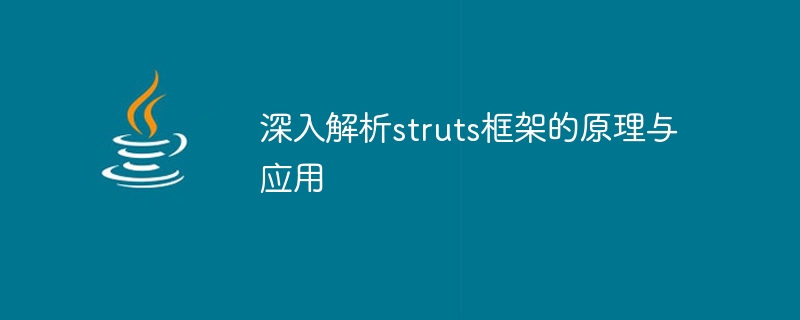Home >Java >javaTutorial >Explore the principles and applications of struts framework
Explore the principles and applications of struts framework
- 王林Original
- 2024-01-04 08:19:061382browse

In-depth analysis of the principles and applications of the Struts framework
Abstract: The Struts framework is an excellent Java Web application development framework, which is based on the MVC design pattern and a series of The tag library and interceptors provide developers with a simple and standardized way to build web applications. This article will provide an in-depth analysis of the principles and applications of the Struts framework, including the framework's working principle, main components, and sample code to demonstrate its specific applications.
1. Working principle of Struts framework
The Struts framework is based on the MVC (Model-View-Controller) design pattern, in which the model (Model) is responsible for processing business logic and data access, and the view (View) is responsible for display Data, controller (Controller) is responsible for processing user requests and scheduling appropriate models and views. Below we will introduce in detail how the Struts framework works.
1.1 Controller layer
The core of the Struts framework is the controller layer, which is the Action controller. When a user sends a request, the Struts framework will match the appropriate Action class to process the request based on the configuration information in the configuration file (struts-config.xml). The Action class inherits the Action class provided by Struts or implements the Action interface provided by Struts, overrides the execute() method to process business logic, and returns corresponding results.
1.2 View layer
The view layer is the component responsible for displaying data in the Struts framework. Struts simplifies developers' work of writing code in JSP pages by providing a tag library (Struts Tag Library). Tags such as
1.3 Model Layer
The model layer is the component responsible for processing business logic and data access in the Struts framework. Developers usually use POJO classes (Plain Old Java Object) as model objects, use JavaBean specifications to encapsulate properties, and provide corresponding access methods. The Struts framework communicates data with the model layer through the ActionForm class.
1.4 Configuration file
The configuration file of the Struts framework mainly includes web.xml and struts-config.xml. The web.xml mainly configures the core controller Servlet of Struts, as well as some filters, etc.; the struts-config.xml file mainly configures the global parameters, Action mapping and corresponding views of Struts.
2. The main components of the Struts framework
In order to better understand the principles of the Struts framework, we need to understand the main components of the Struts framework:
2.1 Action class
The Action class is The core of the Struts framework, responsible for handling every user request. In the Action class, we can write business logic code, obtain parameters from the request object, call the service layer method to process the data, and set the result to the request object or return it to the front end through the return value.
2.2 ActionForm class
The ActionForm class is a JavaBean class that is used to encapsulate the parameters requested by the user and transfer data between different Actions. In the Action class, we can override the validate() method by inheriting the ActionForm class to verify the parameters requested by the user.
2.3 struts-config.xml configuration file
The struts-config.xml file is used to configure the global parameters, Action mapping and corresponding views of the Struts framework. In this configuration file, we can define form validation rules, global exception handling, and configure the mapping between Action and corresponding JSP view.
2.4 Tag Library
Struts provides a series of tag libraries, allowing developers to easily control processes, display data, etc. in JSP pages. For example, the
3. Application example of Struts framework
In order to better understand the application of Struts framework, we will demonstrate it through an example. Suppose we want to develop a user login system, including user registration, user login and other functions.
3.1 Write a user registration page
First, we need to write a user registration page register.jsp. In this page, we use the Struts tag library to control form submission and validation, such as using the
<%@ taglib prefix="struts" uri="http://struts.apache.org/tags-html"%>
<html>
<body>
<h3>用户注册</h3>
<struts:form action="/register" method="post">
<struts:textfield property="username" label="用户名" />
<struts:textfield property="password" label="密码" />
<input type="submit" value="注册" />
</struts:form>
<struts:errors />
</body>
</html>3.2 Create Action Class
After receiving the user registration request, the Struts framework will call the corresponding Action class to process the request. We need to write a RegisterAction class, which inherits from the Action class provided by Struts, and write code to handle business logic in the execute() method, such as saving user registration information to the database.
public class RegisterAction extends Action {
private String username;
private String password;
public String execute() throws Exception {
// 处理注册逻辑,将用户信息保存到数据库
return "success";
}
// 省略getter和setter方法
}3.3 Configure struts-config.xml file
In the struts-config.xml file, we need to configure the mapping relationship between Action and the corresponding JSP view, as well as form validation rules, etc.
<struts-config>
<form-beans>
<form-bean name="registerForm" type="com.example.RegisterForm" />
</form-beans>
<action-mappings>
<action path="/register" type="com.example.RegisterAction" name="registerForm"
input="/register.jsp" scope="request">
<forward name="success" path="/welcome.jsp" />
</action>
</action-mappings>
</struts-config>In the above configuration, we map the RegisterAction class to the path "/register" and specify the ActionForm class as RegisterForm. If the registration fails, it will return to the register.jsp page, otherwise it will jump to the welcome.jsp page.
Conclusion
This article deeply analyzes the principles and applications of the Struts framework, and demonstrates its specific application scenarios through sample code. I hope that readers can have a deeper understanding of the Struts framework through the introduction of this article, so that it can be better applied in actual project development.
The above is the detailed content of Explore the principles and applications of struts framework. For more information, please follow other related articles on the PHP Chinese website!

